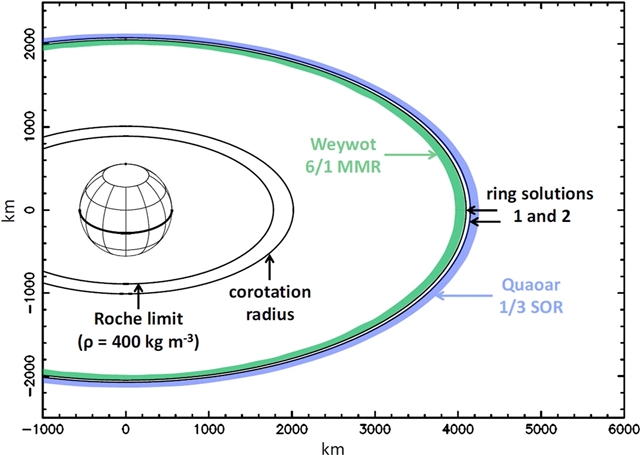
巴西国家天文台B. E. Morgado研究组取得新进展。他们报道了飞越海王星的天体夸欧尔在其罗氏极限外的密集环。2023年2月8日,国际知名学术期刊《自然》发表了这一成果。
该研究组报告了在跨海王星天体(50000)Quaoar周围观测到的一个不均匀环。这个跨海王星天体的半径估计为555公里,并拥有一颗大约80公里的卫星(Weywot),其轨道为24 Quaoar半径。探测到的环的轨道距离中心的半径为7.4,这远远超出了Quaoar的经典罗氏极限,因此表明这个极限并不总是决定环的物质可以在哪里生存。他们的局部碰撞模拟表明,基于实验室实验的弹性碰撞可以保持一个远离物体的环。
此外,Quaoar的环轨道接近于与Quaoar的1/3自旋轨道共振,这是Chariklo和Haumea的3个环所共有的性质,这表明这种共振在小天体的环约束中起着关键作用。
研究人员表示,行星环不仅在巨行星周围被观测到,也在小天体周围被观测到,如半人马座的查里克洛和矮行星妊神星。到目前为止,所有已知的高密度环都位于离母体足够近的地方,处于罗氏极限内,在罗氏极限内,潮汐力阻止了密度合理的物质聚集成卫星。
附:英文原文
Title: A dense ring of the trans-Neptunian object Quaoar outside its Roche limit
Author: Morgado, B. E., Sicardy, B., Braga-Ribas, F., Ortiz, J. L., Salo, H., Vachier, F., Desmars, J., Pereira, C. L., Santos-Sanz, P., Sfair, R., de Santana, T., Assafin, M., Vieira-Martins, R., Gomes-Jnior, A. R., Margoti, G., Dhillon, V. S., Fernndez-Valenzuela, E., Broughton, J., Bradshaw, J., Langersek, R., Benedetti-Rossi, G., Souami, D., Holler, B. J., Kretlow, M., Boufleur, R. C., Camargo, J. I. B., Duffard, R., Beisker, W., Morales, N., Lecacheux, J., Rommel, F. L., Herald, D., Benz, W., Jehin, E., Jankowsky, F., Marsh, T. R., Littlefair, S. P., Bruno, G., Pagano, I., Brandeker, A., Collier-Cameron, A., Florn, H. G., Hara, N., Olofsson, G., Wilson, T. G., Benkhaldoun, Z., Busuttil, R., Burdanov, A., Ferrais, M., Gault, D., Gillon, M., Hanna, W., Kerr, S., Kolb, U., Nosworthy, P., Sebastian, D., Snodgrass, C., Teng, J. P., de Wit, J.
Issue&Volume: 2023-02-08
Abstract: Planetary rings are observed not only around giant planets1, but also around small bodies such as the Centaur Chariklo2 and the dwarf planet Haumea3. Up to now, all known dense rings were located close enough to their parent bodies, being inside the Roche limit, where tidal forces prevent material with reasonable densities from aggregating into a satellite. Here we report observations of an inhomogeneous ring around the trans-Neptunian body (50000) Quaoar. This trans-Neptunian object has an estimated radius4 of 555km and possesses a roughly 80-km satellite5 (Weywot) that orbits at 24 Quaoar radii6,7. The detected ring orbits at 7.4radii from the central body, which is well outside Quaoar’s classical Roche limit, thus indicating that this limit does not always determine where ring material can survive. Our local collisional simulations show that elastic collisions, based on laboratory experiments8, can maintain a ring far away from the body. Moreover, Quaoar’s ring orbits close to the 1/3 spin–orbit resonance9 with Quaoar, a property shared by Chariklo’s2,10,11 and Haumea’s3 rings, suggesting that this resonance plays a key role in ring confinement for small bodies.
DOI: 10.1038/s41586-022-05629-6
Source: https://www.nature.com/articles/s41586-022-05629-6
Nature:《自然》,创刊于1869年。隶属于施普林格·自然出版集团,最新IF:69.504
官方网址:http://www.nature.com/
投稿链接:http://www.nature.com/authors/submit_manuscript.html
